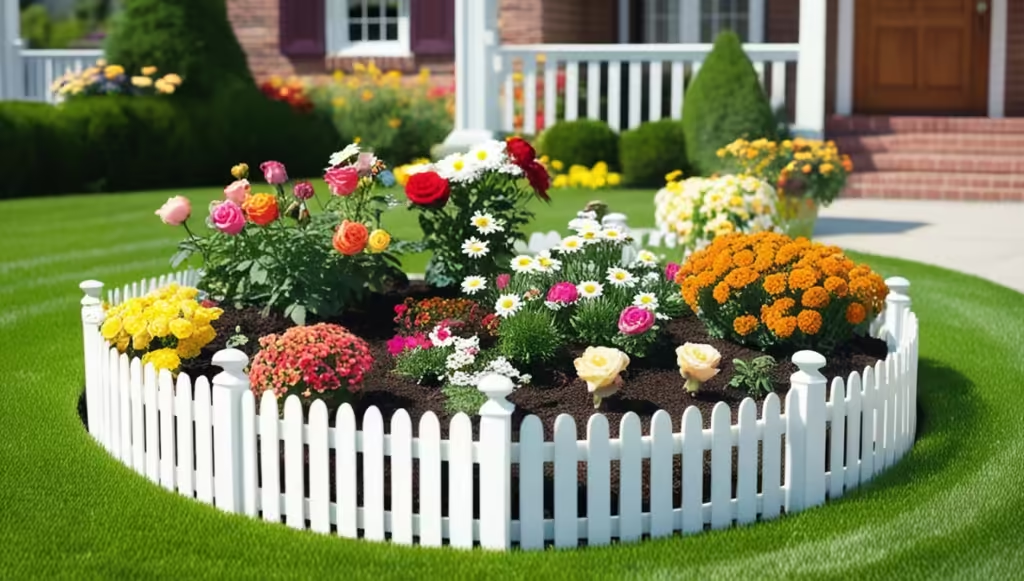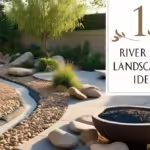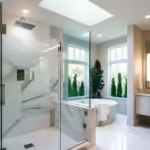A well-designed front flower bed can transform the look of your home, creating an inviting and aesthetically pleasing first impression. Whether you have a small yard or a sprawling garden, there are numerous ways to enhance your home’s curb appeal. Below, we explore 11 front flower bed ideas in great detail, covering design styles, plant combinations, and tips to make your flower beds a showstopper.
1. Curved Flower Beds for a Natural Look
Curved flower beds create a more natural and relaxed appearance compared to straight, geometric lines. This design works exceptionally well for homes with a more rustic or cottage-style aesthetic.
To achieve this look, outline your flower bed with a garden hose or rope to plan the curves. Fill the bed with a mix of perennials, shrubs, and low-growing annuals like petunias or marigolds. Consider incorporating ornamental grasses like fountain grass or feather reed grass to add texture and height. Mulch the area with bark or wood chips for weed control and to keep the soil moist.

2. Symmetrical Beds for Formal Elegance
Symmetrical flower beds provide a formal and balanced look that complements traditional and colonial-style homes. Place identical plants and features on either side of your entrance or walkway.
Start with a central focal point, such as a topiary, a birdbath, or a small ornamental tree like a Japanese maple. Surround the focal point with concentric layers of flowers, using taller plants like delphiniums or foxgloves in the back and shorter blooms like pansies or alyssums in the front.

3. Raised Flower Beds for Easy Maintenance
Raised flower beds not only improve drainage but also make gardening more accessible. These beds can be made from materials like wood, stone, or bricks, and they add a structured, modern look to your front yard.
Choose plants that suit the height and size of the bed. Layer the bed with nutrient-rich soil and compost to ensure healthy growth. Use a combination of evergreen shrubs, flowering perennials, and trailing plants like ivy or creeping jenny for an elegant cascading effect.

4. Cottage Garden Flower Beds
For a whimsical and charming appeal, opt for a cottage garden flower bed. This style embraces a mix of colorful flowers and lush greenery in an unstructured design.
Combine classic blooms like roses, daisies, and hollyhocks with herbs like lavender or thyme for fragrance. Avoid rigid patterns; instead, aim for a more natural and abundant look. Adding a white picket fence or stone border can complete the cottage-style aesthetic.

5. Rock Garden Flower Beds
If you prefer a low-maintenance option, rock gardens are an excellent choice. They combine hardy plants with decorative rocks for a rugged yet beautiful look.
Choose drought-tolerant plants like succulents, sedums, and agave. Arrange rocks in varying sizes throughout the bed to create visual interest. Add a few flowering plants like dianthus or creeping phlox to soften the look.

6. Monochromatic Flower Beds
A monochromatic flower bed can create a striking visual impact with its unified color scheme. This idea is perfect for minimalist homes or anyone looking to make a bold statement.
Pick a color theme—such as shades of purple, pink, or white—and choose plants that bloom in that palette. For instance, a purple-themed flower bed might include lavender, salvia, and purple coneflowers. Use contrasting green foliage for balance and depth.

7. Seasonal Flower Beds
For year-round appeal, design a flower bed with seasonal plants that bloom at different times. This ensures that your front yard looks vibrant no matter the season.
Include spring bulbs like tulips and daffodils, summer perennials like daylilies, fall bloomers like asters, and winter-interest plants like hellebores. Incorporate evergreen shrubs to provide structure during dormant seasons.

8. Butterfly and Pollinator-Friendly Beds
Attract butterflies, bees, and other pollinators with a flower bed designed to support local wildlife. Not only will this benefit your garden’s ecosystem, but it will also create a lively, colorful display.
Choose nectar-rich flowers like butterfly bushes, milkweed, and lantanas. Add plants that bloom in various shapes, sizes, and colors to accommodate different species. Avoid using pesticides to keep the environment safe for pollinators.

9. Tiered Flower Beds for Depth and Dimension
Tiered flower beds add depth and a layered effect to your front yard. They’re especially useful for sloped landscapes but can also be constructed on flat terrain using raised platforms or retaining walls.
Plant taller species like hydrangeas or sunflowers in the back, medium-height plants like peonies or zinnias in the middle, and low-growing plants like lobelia or ground cover at the front.

10. Themed Flower Beds
A themed flower bed can be a unique way to express your personal style. For example, you could create a tropical bed with vibrant plants like hibiscus, bird of paradise, and canna lilies. Alternatively, a zen garden bed might feature bamboo, moss, and a small water feature.
Choose accessories like statues, lanterns, or decorative stones to reinforce the theme and make it cohesive.

11. Edible Flower Beds
Combine beauty and function by incorporating edible plants into your front flower bed. Not only will this provide fresh herbs and vegetables, but it will also create a unique and practical garden space.
Plant flowering herbs like basil, chives, and thyme alongside edible flowers like nasturtiums and calendula. Add compact vegetables like cherry tomatoes or kale for variety. Ensure the layout remains visually appealing by balancing edible plants with ornamental ones.

Additional Tips for Designing Front Flower Beds
- Lighting: Use solar or LED lights to highlight your flower bed in the evenings.
- Soil Preparation: Ensure the soil is well-drained and enriched with organic matter for optimal plant growth.
- Watering: Install drip irrigation for efficient watering.
- Borders: Use decorative edging materials like bricks, stones, or metal to give the flower bed a polished look.
FAQs About Front Flower Beds
What are the best flowers for a front yard?
Some popular options include petunias, marigolds, begonias, and hydrangeas. These flowers are known for their vibrant colors and adaptability.
How do I maintain a front flower bed?
Regularly weed your flower bed, prune dead or overgrown plants, and mulch to retain soil moisture. Fertilize every few weeks for optimal growth.
What is the ideal size for a front flower bed?
The size depends on your yard’s dimensions, but aim for a proportionate design that complements your home. Leave enough space for walking paths and other landscaping elements.
How can I make a flower bed more eco-friendly?
Use native plants that require less water and maintenance. Avoid synthetic fertilizers and pesticides, and consider installing a rainwater collection system for irrigation.
Verdict
Creating a stunning front flower bed takes careful planning and creativity. By following these ideas and tips, you can design a space that not only enhances your home’s curb appeal but also brings joy every time you pull into the driveway.

Haris Virk is the creative force and expert content strategist behind ScrapSafari.com. As an accomplished writer and designer, Haris leads the development of innovative content and visually stunning images that captivate audiences. His extensive experience in crafting engaging articles and unique design ideas makes him a pivotal contributor to ScrapSafari’s success.
Haris’s keen eye for aesthetics and trend forecasting ensures that every piece he produces not only informs but also inspires readers. His proficiency extends to mastering Pinterest strategies, where his thoughtfully crafted pins drive significant traffic and amplify the site’s reach.
With a passion for creativity and a deep understanding of content dynamics, Haris Virk brings a distinctive blend of originality and strategic thinking to the ScrapSafari team, solidifying its place as a go-to source for design, ideas, and inspiration.


